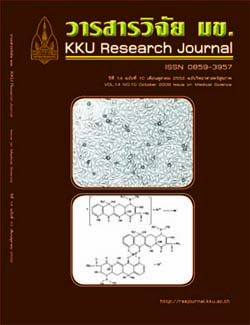Anti-proliferative effect of PRKAR1A gene suppression by RNA interference in cholangiocarcinoma cell line
Main Article Content
Abstract
Cholangiocarcinoma (CCA) induced by liver fluke (Opisthorchis viverrini, Ov) infection is one of the most common and serious diseases in northeast Thailand. We have previously reported significant overexpression of c-AMP dependent protein kinase regulatory subunit A (PRKAR1A) mRNA in Ov and N-nitrosodimethylamine (NDMA)-induced CCA in hamsters, suggesting that PRKAR1A is strongly involved in CCA carcinogenesis. The present work aimed to elucidate whether PRKAR1A is suitable to be the potential target for inhibiting CCA cell growth. To prove this hypothesis, the RNA interference (siRNA) technique was used to determine the anti-proliferative effect of PRKAR1A gene suppression on a CCA cell line. The siRNA treatment leaded to the suppression of the PRKAR1A mRNA and protein expression resulting in the reduction of CCA cell proliferation (p < 0.01). The inhibition of PRKAR1A expression leading to reduction of CCA cell growth suggests that this molecule may be used as a drug target for CCA therapy.
Article Details
References
Cho-Chung, Y.S., Nesterova M., Kondrashin A.,Noguchi K., Srivastava R.and Pepe S. 1997.Antisense-protein kinase A: a single-gene-based therapeutic approach. AntisenseNucleic Acid Drug Dev 7(3):217-223.
Cho-Chung, Y.S., Nesterova M., Pepe S., Lee G.R.,Noguchi K., Srivastava R.K., SrivastavaA.R., Alper O., Park Y.G.and Lee Y.N.1999. Antisense DNA-targeting proteinkinase A-RIA subunit: a novel approach tocancer treatment. Front Biosci 4(D898-907.
Cho-Chung, Y.S., Pepe S., Clair T., Budillon A.andNesterova M. 1995. cAMP-dependentprotein kinase: role in normal and malignantgrowth. Crit Rev Oncol Hematol 21(1-3):33-61.
Farrow, B., Rychahou P., Murillo C., OûConnor KL., Iwamura T.and Evers B.M. 2003.Inhibition of pancreatic cancer cell growthand induction of apoptosis with noveltherapies directed against protein kinaseA. Surgery 134(2):197-205.
Krebs, E.G. 1972. Protein kinases. Curr Top CellRegul 5(99-133.
Livak, K.J.and Schmittgen T.D. 2001. Analysis ofrelative gene expression data using real-timequantitative PCR and the 2(-Delta DeltaC(T)) Method. Methods 25(4):402-408.
Loilome, W., Yongvanit P., Wongkham C., TepsiriN., Sripa B., Sithithaworn P., Hanai S.andMiwa M. 2006. Altered gene expression inOpisthorchis viverrini-associated cholangiocarcinomain hamster model. Mol Carcinog 45(5):279-287.
Mantovani, G., Bondioni S., Lania sA.G., RodolfoM., Peverelli E., Polentarutti N., VelizRodriguez T., Ferrero S., Bosari S., Beck-PeccozP. and Spada A. 2008. High expression ofPKA regulatory subunit 1A protein is relatedto proliferation of human melanoma cells.Oncogene 27(13):1834-1843.
Nesterova, M.and Cho-Chung Y.S. 2000. Oligonucleotidesequence-specific inhibition of geneexpression, tumor growth inhibition, andmodulation of cAMP signaling by an RNA-DNA hybrid antisense targeted to proteinkinase A RIalpha subunit. AntisenseNucleic Acid Drug Dev 10(6):423-433.
Nesterova, M.V.and Cho-Chung Y.S. 2004. Antisenseprotein kinase A RIalpha inhibits 7,12-dimethylbenz(a)anthracene-induction ofmammary cancer: blockade at the initialphase of carcinogenesis. Clin Cancer Res10(13):4568-4577.
Parkin, D.M., Srivatanakul P., Khlat M., ChenvidhyaD., Chotiwan P., Insiripong S., L-AbbeK.A.and Wild C.P. 1991. Liver cancer inThailand. I. A case-control study ofcholangiocarcinoma. Int J Cancer48(3):323-328.
Tortora, G., Bianco R ., Damiano V., Fontanini G.,De Placido S., Bianco A.R.and CiardielloF. 2000. Oral antisense that targets proteinkinase A cooperates with taxol and inhibitstumor growth, angiogenesis, and growthfactor production. Clin Cancer Res6(6):2506-2512.
Tortora, G., Caputo R., Damiano V., Bianco R.,Fontanini G., Cuccato S., De Placido S.,Bianco A.R.and Ciardiello F. 2001a.Combined blockade of protein kinase Aand bcl-2 by antisense strategy inducesapoptosis and inhibits tumor growth andangiogenesis. Clin Cancer Res 7(8):2537-2544.
Tortora, G., Caputo R., Damiano V., Fontanini G.,Melisi D., Veneziani B.M., Zunino F.,Bianco A.R.and Ciardiello F. 2001b. Oraladministration of a novel taxane, anantisense oligonucleotide targeting proteinkinase A, and the epidermal growth factorreceptor inhibitor Iressa causes cooperativeantitumor and antiangiogenic activity. ClinCancer Res 7(12):4156-4163.
Tortora, G., Caputo R., Damiano V., Melisi D.,Bianco R., Fontanini G., Veneziani B.M.,De Placido S., Bianco A.R.and CiardielloF. 2003. Combination of a selectivecyclooxygenase-2 inhibitor with epidermalgrowth factor receptor tyrosine kinaseinhibitor ZD1839 and protein kinase Aantisense causes cooperative antitumor andantiangiogenic effect. Clin Cancer Res9(4):1566-1572.
Tortora, G.and Ciardiello F. 2000. Targeting ofepidermal growth factor receptor and proteinkinase A: molecular basis and therapeuticapplications. Ann Oncol 11(7):777-783.
Wang, H., Cai Q., Zeng X., Yu D., Agrawal S.andZhang R. 1999. Antitumor activity andpharmacokinetics of a mixed-backboneantisense oligonucleotide targeted to theRIalpha subunit of protein kinase A afteroral administration. Proc Natl Acad Sci US A 96(24):13989-13994.


